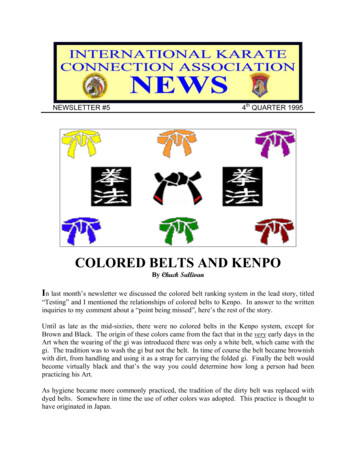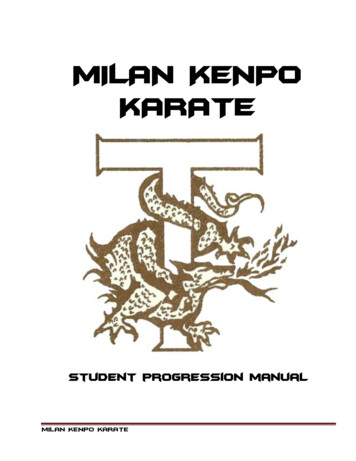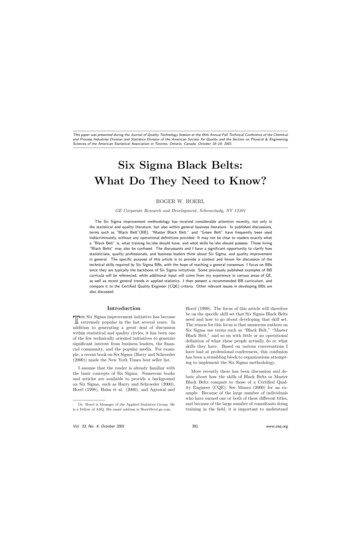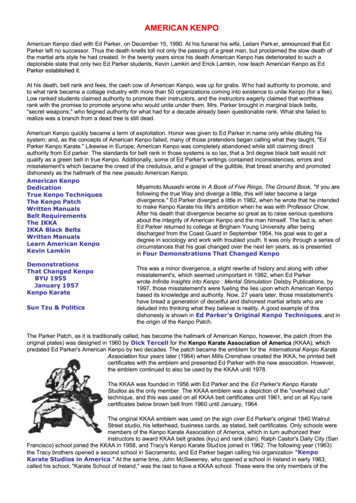
Transcription
4th QUARTER 1995NEWSLETTER #5COLORED BELTS AND KENPOBy Chuck SullivanIn last month’s newsletter we discussed the colored belt ranking system in the lead story, titled“Testing” and I mentioned the relationships of colored belts to Kenpo. In answer to the writteninquiries to my comment about a “point being missed”, here’s the rest of the story.Until as late as the mid-sixties, there were no colored belts in the Kenpo system, except forBrown and Black. The origin of these colors came from the fact that in the very early days in theArt when the wearing of the gi was introduced there was only a white belt, which came with thegi. The tradition was to wash the gi but not the belt. In time of course the belt became brownishwith dirt, from handling and using it as a strap for carrying the folded gi. Finally the belt wouldbecome virtually black and that’s the way you could determine how long a person had beenpracticing his Art.As hygiene became more commonly practiced, the tradition of the dirty belt was replaced withdyed belts. Somewhere in time the use of other colors was adopted. This practice is thought tohave originated in Japan.
Unfortunately, my memory fails me as to exactly when the following took place, but in lookingat the Official Program from the 1965 International Karate Championships held in Long beach Ifound an article on Bob Cook (one of Ed Parker’s students from his West L.A. school who hadwon the Heavyweight White Belt title the year earlier and if I’m not mistaken Ed Parker’s KenpoKarate system was still using only the white belt with brown stripes to indicate rank within thatlevel. So it was sometime after 1964 or 1965 that I went to Mr. Parker with my observations andthoughts on the use of colored belts within the white belt rankings. Here’s what led up to it:The early sixties was a tournament crazy time. Everybody from toddlers to doctors entered andfought for the rerputation of their school and personal glory. It was a frivolous time. Except forcups and an occasional pair of shin guards there was virtually no protective equipment. Wefought on bare concrete floors and knockouts ran rampant. There was little sophistication oftechnique. Here were grown men who already had the ability to kill one another and now, thetraining to do it quickly but hadn’t studied long enough to have learned, let alone mastered, thetechniques of truly defending themselves against the aggressive techniques everybody seemed tobe concentrating on. It was mayhem in its entire splendor. If ever there was a day of the ModernGladiator that was it.About that time I began to notice an odd phenomenon. One school’s students were seeminglywinning all the titles, at all the tournaments, up to, but not including Black Belt. At the BlackBelt level they did about the same as anyone else but in the lower divisions they ran away witheverything. These guys were no better than anyone else but their record was! How come?Things like that perplex and frustrate me and if there is a logical answer, I want it.The whole thing became clear, when I discovered there was a differential in the time framebetween their promotions to Brown Belt and ours. The usual length of time from beginner toBlack Belt was about four years. That was traditional for just about all schools and systems, atthat time. Training and the volume of material was dissimilar then. It was primitive incomparison.The school that was doing all the winning was holding their students off for Brown Belt for anadditional year. It took their students three years to make Brown Belt. Think about that! Whatdoes an additional year mean? It means that their students fighting in the white belt division whowere in their third year were actually Brown Belts fighting in a lower division. It also meant thatall of the Brown Belts had at least a year on all others just coming into that division. What anadvantage!It was at that point I went to Mr. Parker with my revelation. I knew he would want to give ourpeople the same advantage so I devised a plan that I thought would surely meet with hisapproval. I furst suggested that we go to the colored belt ranking system. He rejected thatimmediately. He said. “It’s not Kenpo, it’s not in the Chinese tradition.” My counter was,“Neither is brown or black belt, in fact neither is the whole belt ranking system.” He had toconcede that one. So, following that logic, if we were already violating tradition, with brownand black belts and brown tips on the white belts, why not go all the way and replace the tipswith colored belts. My argument was that the adding of a stripe to your white belt isn’t nearly as
dramatic as changing belts. If belt ranking is a reward system, why not make is as gratifying aspossible? I approached it as a merchandising strategy.He liked that. He could see the logic in it. He could see the marketing potential. That’s when Ilaunched into my real objective. I felt he would probably disagree with making the students waitan additional year for Brown Belt, even though it was in their best interests. Wow, was I right.When I suggested it and gave him my reasons, he refused to even consider it. I tried to impresshim with how much of a disadvantage our students were competing under, but to no avail. Hejust couldn’t see making people wait another year for Brown Belt, even though the other schoolwas making oit work to such an advantage. He kept repeating the same thing over and over, “Itwouldn’t be fair, Chuck. It just wouldn’t be fair.” I tried using that same logic in reverse,restating how unfair the other school was being to us but that didn’t work either. No matter whatI said, I just couldn’t get my point across. So, the colored belts came into being in the Kenposystem and the other school continued to take advantage of the extra year of training incompetition.This was my first lesson in “YOU CAN’T WIN THEN ALL”(Nor the last)TOM FORD WINS THE“OUTSTANDING VIDEO PERFORMANCE FOR 1995”It may not be an Academy award, but we thought it fitting to at least acknowledge themost outstanding video performance we see each year. Last year Thomas E. Ford ofEverett, Washington, USA turned in a video test for Brown Belt that was trulyextraordinary. He borrowed from techniques to create his own endings that wereincredible and done beautifully. Tom’s a big man who moves with the speed of alightweight and the power of a locomotive.There is no gold statue but there is written recognition.Congratulations Tom!
MEET JOE R. LANDSDALEJoeR. Landsdale is one of your IKCAbrothers.He lives and works inNacogdoches, Texas, USA. Joe is a novelistwho has had over a dozen full length novelspublished.He was recently in the LosAngeles area on a book signing tour thatincluded several cities. We caught up withhim in Westwood for a short visit. I hope nexttime he’s in town he’ll have more time.I had the extreme fortune of reading three ofJoe’s novels which I did in record time.You’ve heard people describe a book with, “Icouldn’t put it down.” Well, that’s how I set arecord. I really couldn’t put them down. Ifyou like mystery, action and adventure and you’ve ever wondered what it’slike in East Texas, pick up a copy of Cold in July, Savage Season orMucho Mojo, the three I read. Anyone will fulfill those requirements and alot more.
BONUS VIDEOSincethe production of the Karate Connection’sVideo Series we have come to the realization thatthere are many principles discussed on thosetapes needed to be presented in a morecomprehensive manner.All of the principles of Kenpo are covered in depthon the video series; however each was introducedat the time it was needed, to illustrate a pointabout the topic being presented at that time. Theyare scattered throughout the tapes and it would bedifficult for a student to treat each as an individualsubject and study it as such, therefore we’vedecided to do it for you. The Karate Connection isvery much a living, breathing entity. It’s growingand evolving all the time. As we find better waysto present the Art we’re not limited to what weestablished in the beginning. We are able to passany improvements on to our video students assoon as we have proven their worth throughexperimentation with our regular group. The absolute beauty of the Karate ConnectionVideo Program is the method of communication we are utilizing, which allows us to dosomething as unique as this.The BONUS VIDEO is thirty-six minutes in length. The subjects covered are: THEELEMENTS OF POWER – THE ELEMENTS OF SPEED – BRATHING AND THE KIAI– COVERING OUT and finally THE MASTER FORM.THE ELEMENTS OF POWERROTATIONAL FORCETORQUECENTRIFUGAL FORCEBACK-UP MASS(Through body alignment and mass-in-motion)SPEEDGRAVITATIONAL FORCETHE ELEMENTS OF SPEEDCOMBINING MULTIPLE MOVEMENTSELIMINATING SUPERFULOUS ACTIVITYUSING CONTINOUS MOTION
BREATHING AND THE KIAITHE CONCEPT OF COMBINING THE TWO INTO AN EASY AND WORKABLEMETHOD, TO REALIZE THE ADVANTAGES THE KIAI IS DESIGNED TO GIVE YOU.COVERING OUTTHE HOW’S WHY’S AND WHEREFORE’S OF STAYING COVEREDAT THE END OF EACH TECHNIQUE.THE MASTER FORMHOW TO VIEW THE MASTER FORM FROM BOTH APRACTICAL AND ESTHETIC PERSPECTIVE.When you pass your Purple Belt test we will dub the contents of this video onto yourtest tape at no additional charge. THIS VIDEO IS NOT FOR SALE. We created thissegment for our students in order to strengthen and expand their understanding of thematerial contained in the regular video series.If you have already achieved your Purple Belt, not to worry, we will dub the BONUSVIDEO onto your next test tape regardless of which test it is. For our Black BeltStudents: We will dub it on the test tape for your next degree, if that’s in the near future,at no additional cost. If it will be too long before your next test and you want it now, youmay send one of your previous test tapes to us to dub it onto. Or, if you prefer, we willpurchase a blank tape for you. If you send your own tape please include the usualshipping and handling fee to return it to you. If you want us to purchase a blank, pleasecall us. Please allow a few weeks for delivery. We are not using the DuplicationCompany that does our regular videos. It’s the only way we can afford to give this toyou, at no actual charge, and we want you to have it.The future is where we will spend the rest of our lives. I would hate to think that theKarate connection is locked in to what was put on our video series at the time we didthem. Things change, attitudes change and while tradition is certainly valued, so isprogress. We’ve kept our minds open from the beginning and hope to, till the end. Butwe’ll never change, just for the sake of change and we’ll never add just for the sake ofhaving more. We will work it out meticulously before we pass it on to you. Even then,we expect you to use your own powers of observation and intellect to determine if youwant to incorporate a suggestion or leave it.Some things in the future will not be optional, such as; we are going to require sometwo-minute freestyle matches before you reach the black Belt level. We’ve found that ifwe don’t see you freestyle before Black Belt it isn’t fair to you for us to hold up yourpromotion based on your freestyle performance. If we see it beforehand and it isn’t upto par we can be instrumental in guiding you toward a passing performance. We areconstantly striving to give you a program of which you can be proud. For your rank tohave true value the program must have true value. It’s no different from when we gotour belts from the “Old Man”. He didn’t make it easy either, he just made it possible.
YOUR IKCA FAMILY TREELineage is defined as:The descendants of a common ancestorConsidered to be the founder of the line.That’s why we decided to commence our Family Tree with the name of ProfessorWilliam K.S. Chow. Before Prof. Chow the style of Kenpo was decidedly moreChinese in nature. It was Prof. Chow who westernized the system to better servehis students in Hawaii. Prof. Chow’s Family Tree would have the names of all ofhis Black Belt students. Among Prof. Chow’s students, who went on to teach andpromote was Edmund K. Parker, who brought Kenpo to the Mainland where hehad to further westernize the system to better serve his students here.Under Ed Parker and the International Kenpo Karate Association are all theBlack Belts promoted by that organization. In turn, each Black Belt whoultimately went on to teach and promote, has his or her own listing. Under thename Chuck Sullivan on the Ed Parker Family Tree are fifteen names. There is anasterisk behind each name to indicate that these Black belts were also taught by EdParker personally, because the school Chuck Sullivan ran was a partnershipbetween he and Ed Parker.Of the fifteen black Belts under Chuck Sullivan, three went on to teach andpromote under their own auspices. They in turn are listed with the names of theirBlack Belts, with the exception of those under Steve Sanders because of the lengthof the list.One of the Black Belts under Chuck Sullivan is Vic LeRoux. The InternationalKarate Connection Association was founded by Chuck Sullivan and Vic LeRouxand under that joint venture are the names of the Black Belts promoted within theInternational Karate Connection Association. That’s where your Family Tree willbegin, but those listed before you should also be included, so that your studentsknow your and their lineage.
Letters to the EditorWe got a couple of good ones this quarter; I think you’ll enjoy them.The first is from Alan J. Nisberg of Tampa, Florida, USA.Thank you, Alan!Dear Editor,This is in response to the letter by Teddi W. Nowicki which appeared in Newsletter #4.First, I believe I speak for all of the IKCA Kenpo practitioners who live too fat from theIKCA Headquarters (home base) to attend classes in person on a daily basis when Isay;You are extremely lucky to have Chuck and Vic in your home town!!I was fortunate enough to have the opportunity to get to know Chuck, Vic and some ofthe
COLORED BELTS AND KENPO By Chuck Sullivan In last month’s newsletter we discussed the colored belt ranking system in the lead story, titled “Testing” and I mentioned the relationships of colored belts to Kenpo. In answer to the written inquiries to my comment about a “point being missed”, here’s the rest of the story. Until as late as the mid-sixties, there were no colored belts in .











